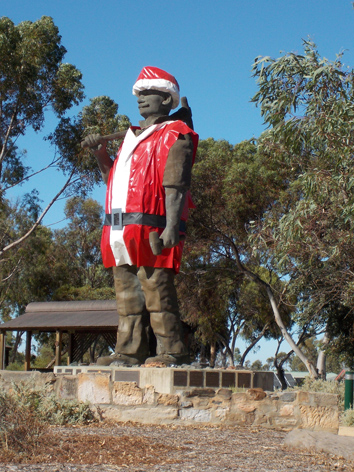Edges of place; familiarity vs. recognition
Sue Michael, Kelpie waits for the school children to return home, 2014, acrylic on canvas, 60 x 90 cm
There is a difference between an edge and a boundary in place studies. They both have ties to any specific place, but boundaries suggest a walled off and partitioned enclosure. Edges to place may be more appropriate a term as it forwards the idea that there is an ever-moving and permeable fringe to places, in much the same way that this home has a flexible edge. The black dog is waiting for the children to come home, and by being seated there he is extending the edge in a welcoming gesture. The staggered pot plants also suggest open entry points rather than a fixed edge. My hope is that artists could consider that home‘s edge may be the front door, but it also could extend to the gate, the street and the suburb.
Edges are seen when you look.
Edges can be imagined. We have neighbours with a swimming pool and on certain days the edge of that pool extends out, accompanied by the sounds of splashing and the squealing of the young users. I do not see them, but I see them in my mind’s eye, and in the process the pool is now, metaphorically, in my yard. Edges can be designated, much like the old rainwater tanks, or hay bales that are painted with the winning football teams championship news, along country roads. Travellers now know you are entering a certain territory with such signs.
Sue Michael, Map the Miner at Xmas time, Kapunda, 2015, digital photograph
Small towns often display public art and signage at the edge of the town, not at the centre. This edge of town is often known by experience whether it is bend that you turn onto from the top of a hill, or a grand and carefully crafted sign, or a sculpture. Perhaps that same hill, sign or sculpture can be seen for miles. People become familiar with edges, and may have a visceral response when they encounter edges to a place. I am reminded of the first whiffs of antiseptic at my childhood dentist…visceral responses are, indeed, possible when entering the edges of places. The artist can consider these place thresholds and the bodily responses that can potentially occur. How do you draw the bass beats of the nightclub that you hear in the street before entering? How do you draw the smells of the zoo that you notice from the car park? How do you draw the music that accompanies the fireworks?
How can you experience an edge from within…or from outside that place? Could you draw the waiting dog’s view, as well as the homeward bound child’s view of the edges of place? These questions are steeped in lived experience. There may be an emerging awareness that edges may be hard to pin down, for they are not generic rims and can have multiple aspects to consider. The artist may hone their skills in corporeal meanings, how their body responds to passing the threshold of a place. If in doubt, think of the ghost train of your childhood…and the waiting parents, and the youths paid to touch shoulders, and the bored operator, and the screaming self ( in my case).
Every edge of a place is interactive.

